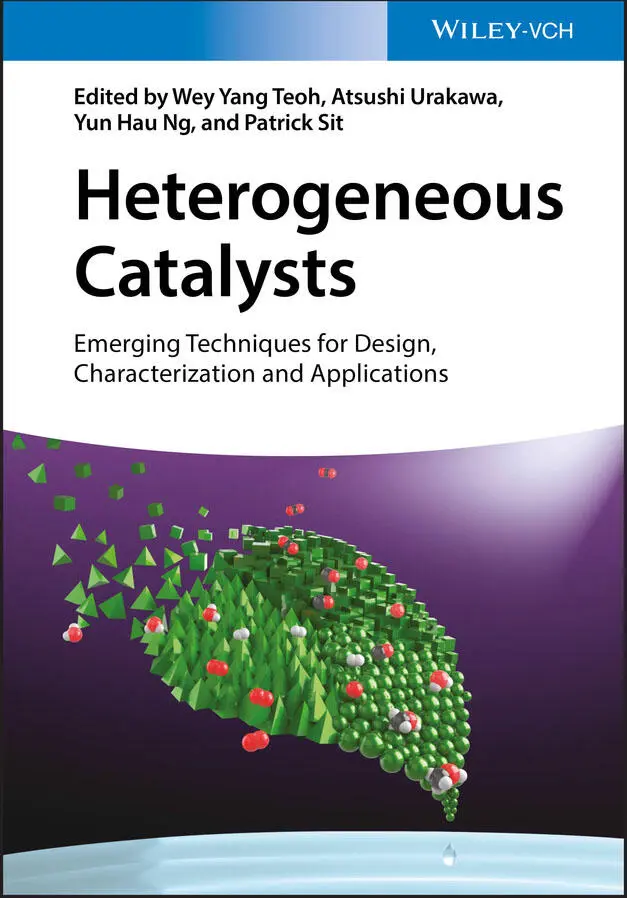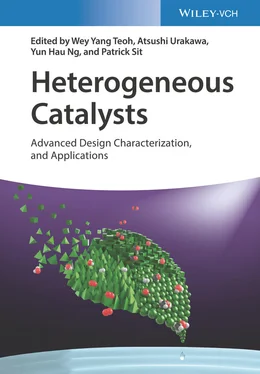
1 Cover
2 Title Page Heterogeneous Catalysts Advanced Design, Characterization and Applications Edited by Wey Yang Teoh, Atsushi Urakawa, Yun Hau Ng, and Patrick Sit Volume 1
3 copyright Editors Prof. Wey Yang Teoh University of Malaya Department of Chemical Engineering 50603 Kuala Lumpur Malaysia Prof. Atsushi Urakawa Delft University of Technology Faculty of Applied Sciences Building 58 E2 100 Van der Maasweg 9 2629 Delft The Netherlands Prof. Yun Hau Ng City University of Hong Kong School of Energy and Environment Tat Chee Avenue Kowloon Hong Kong, S.A.R. Prof. Patrick Sit City University of Hong Kong School of Energy and Environment Tat Chee Avenue Kowloon Hong Kong, S.A.R. Cover Cover image: Courtesy of Wey Yang Teoh and Nat Phongprueksathat All books published by Wiley‐VCH are carefully produced. Nevertheless, authors, editors, and publisher do not warrant the information contained in these books, including this book, to be free of errors. Readers are advised to keep in mind that statements, data, illustrations, procedural details or other items may inadvertently be inaccurate. Library of Congress Card No.: applied for British Library Cataloguing‐in‐Publication Data A catalogue record for this book is available from the British Library. Bibliographic information published by the Deutsche Nationalbibliothek The Deutsche Nationalbibliothek lists this publication in the Deutsche Nationalbibliografie; detailed bibliographic data are available on the Internet at < http://dnb.d-nb.de >. © 2021 WILEY‐VCH GmbH, Boschstr. 12, 69469 Weinheim, Germany All rights reserved (including those of translation into other languages). No part of this book may be reproduced in any form – by photoprinting, microfilm, or any other means – nor transmitted or translated into a machine language without written permission from the publishers. Registered names, trademarks, etc. used in this book, even when not specifically marked as such, are not to be considered unprotected by law. Print ISBN: 978‐3‐527‐34415‐4 ePDF ISBN: 978‐3‐527‐81356‐8 ePub ISBN: 978‐3‐527‐81358‐2 oBook ISBN: 978‐3‐527‐81359‐9
4 Preface
5 Section I: Heterogeneous Catalysts Design and Synthesis 1 Evolution of Catalysts Design and Synthesis: From Bulk Metal Catalysts to Fine Wires and Gauzes, and that to Nanoparticle Deposits, Metal Clusters, and Single Atoms 1.1 The Cradle of Modern Heterogeneous Catalysts 1.2 The Game Changer: High‐Pressure Catalytic Reactions 1.3 Catalytic Cracking and Porous Catalysts 1.4 Miniaturization of Metal Catalysts: From Supported Catalysts to Single‐Atom Sites 1.5 Perspectives and Opportunities References 2 Facets Engineering on Catalysts 2.1 Introduction 2.2 Mechanisms of Facets Engineering 2.3 Anisotropic Properties of Crystal Facets 2.4 Effects of Facets Engineering 2.5 Outlook References 3 Electrochemical Synthesis of Nanostructured Catalytic Thin Films 3.1 Introduction 3.2 Principle of Electrochemical Method in Fabricating Thin Film 3.3 Conclusions and Perspective References 4 Synthesis and Design of Carbon‐Supported Highly Dispersed Metal Catalysts 4.1 Introduction 4.2 Preparation of Catalysts on New Carbon Supports 4.3 Emerging Techniques for Carbon‐Based Catalyst Synthesis 4.4 Conclusions and Outlook References 5 Metal Cluster‐Based Catalysts 5.1 Introduction 5.2 Catalysts Made by Deposition of Clusters from the Gas Phase Under Ultrahigh Vacuum 5.3 Chemically Synthesized Metal Clusters 5.4 Catalysis Using the Chemically Synthesized Metal Clusters 5.5 Conclusion References 6 Single‐Atom Heterogeneous Catalysts 6.1 Introduction 6.2 Concept and Advantages of SACs 6.3 Synthesis of SACs 6.4 Challenges and Perspective References 7 Synthesis Strategies for Hierarchical Zeolites 7.1 Introduction 7.2 Hierarchical Zeolites 7.3 Modern Strategies for the Synthesis of Hierarchical Zeolites 7.4 Conclusion References 8 Design of Molecular Heterogeneous Catalysts with Metal–Organic Frameworks 8.1 Secondary Building Units (SBUs) and Isoreticular MOFs 8.2 The Tools to Build Molecular Active Sites: Reticular Chemistry and Beyond 8.3 MOFs in Catalysis 8.4 Conclusion: Where to Go from Here References 9 Hierarchical and Anisotropic Nanostructured Catalysts 9.1 Introduction 9.2 Top‐Down vs. Bottom‐Up Approaches 9.3 Shape Anisotropy and Nanostructured Assemblies 9.4 Janus Nanostructures 9.5 Hierarchical Porous Catalysts 9.6 Functionalization of Porous/Anisotropic Substrates 9.7 Perspective References 10 Flame Synthesis of Simple and Multielemental Oxide Catalysts 10.1 From Natural Aerosols Formation to Engineered Nanoparticles 10.2 Flame Aerosol Synthesis and Reactors 10.3 Simple Metal Oxide‐Based Catalysts 10.4 Multielemental Oxide‐Based Catalysts 10.5 Perspective and Outlook References 11 Band Engineering of Semiconductors Toward Visible‐Light‐Responsive Photocatalysts 11.1 Basis of Photocatalyst Materials 11.2 Photocatalyst Material Groups 11.3 Design of Band Structures of Photocatalyst Materials 11.4 Preparation of Photocatalysts References
6 Section II: Surface Studies and Operando Spectroscopies in Heterogeneous Catalysis 12 Toward Precise Understanding of Catalytic Events and Materials Under Working Conditions References 13 Pressure Gaps in Heterogeneous Catalysis 13.1 Introduction 13.2 High‐Pressure Studies of Catalysts 13.3 Adsorption on Solid Surfaces at Low and High Pressures 13.4 Conclusions and Outlook Acknowledgments References 14 In Situ Transmission Electron Microscopy Observation of Gas/Solid and Liquid/Solid Interfaces 14.1 Introduction 14.2 Observation in Gas and Liquid Phases 14.3 Applications and Outlook References 15 Tomography in Catalyst Design 15.1 Introduction 15.2 Imaging with X‐Rays 15.3 Conventional Absorption CT to Study Catalytic Materials 15.4 X‐Ray Diffraction Computed Tomography (XRD‐CT) 15.5 Pair Distribution Function CT 15.6 Multimodal XANES‐CT, XRD‐CT, and XRF‐CT 15.7 Atom Probe Tomography 15.8 Ptychographic X‐Ray CT 15.9 Conclusions References 16 Resolving Catalyst Performance at Nanoscale via Fluorescence Microscopy 16.1 Fluorescence Microscopy as Catalyst Characterization Tool 16.2 Basics of Fluorescence and Fluorescence Microscopy 16.3 Strategies to Resolve Catalytic Processes in a Fluorescence Microscope 16.4 Wide‐Field and Confocal Fluorescence Microscopy 16.5 Super‐resolution Fluorescence Microscopy 16.6 What Can We Learn About Catalysts from (Super‐resolution) Fluorescence Microscopy: Case Studies 16.7 Conclusions and Outlook References 17 In Situ Electron Paramagnetic Resonance Spectroscopy in Catalysis 17.1 Introduction 17.2 Basic Principles of Electron Paramagnetic Resonance (EPR) 17.3 Experimental Methods and Setup for In Situ cw‐EPR 17.4 Applications of In Situ EPR Spectroscopy 17.5 Conclusions References 18 Toward Operando Infrared Spectroscopy of Heterogeneous Catalysts 18.1 Brief Theory on Infrared Spectroscopy 18.2 Different Modes of IR Measurements 18.3 Measuring the “Background” 18.4 Using Probe Molecules to Identify Heterogeneous Sites 18.5 IR Measurements Under Operando Conditions 18.6 Case Studies of Operando IR Spectroscopy 18.7 Perspective and Outlook References 19 Operando X‐Ray Spectroscopies on Catalysts in Action 19.1 Fundamentals of X‐Ray Spectroscopy 19.2 X‐Ray Absorption Spectroscopy Methods 19.3 High‐Energy‐Resolution (Resonant) X‐Ray Emission Spectroscopy 19.4 In Situ and Operando Cells 19.5 Application of Time‐Resolved Methods 19.6 Limitations and Challenges 19.7 Concluding Remarks References 20 Methodologies to Hunt Active Sites and Active Species 20.1 Introduction 20.2 Modulation Excitation Technique 20.3 Steady‐State Isotopic Transient Kinetic Analysis (SSITKA) 20.4 Multivariate Analysis 20.5 Outlook References 21 Ultrafast Spectroscopic Techniques in Photocatalysis 21.1 Transient Absorption Spectroscopy 21.2 Time‐Resolved Photoluminescence 21.3 Time‐Resolved Microwave Conductivity References
Читать дальше


